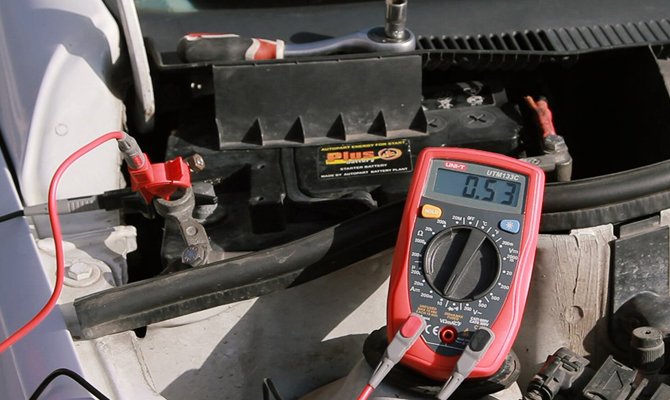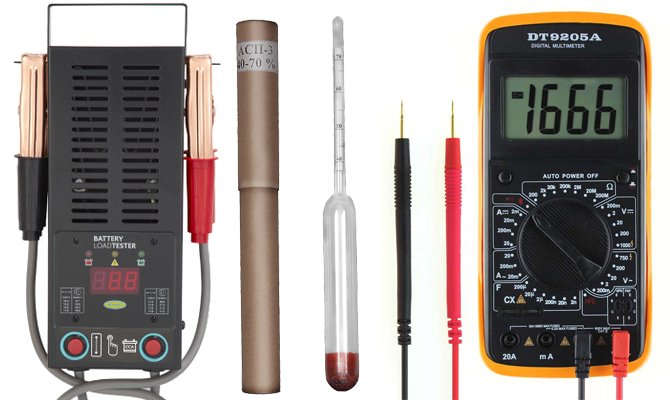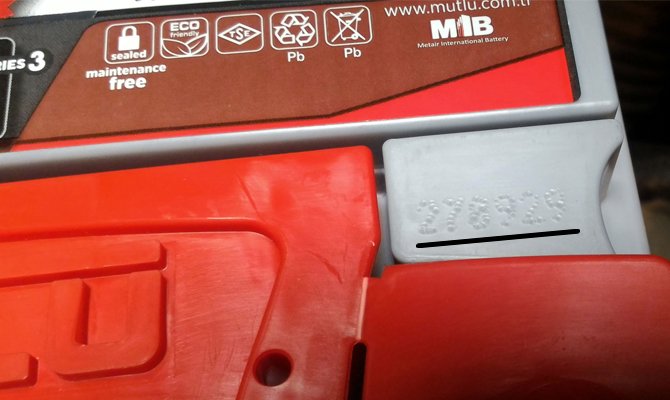Batteries can be easily disabled by short circuiting or staying in a deep discharge for a long time. Each time after the occurrence of such situations, as well as with mechanical damage to the product, it is necessary to conduct a thorough check of the battery. How to carry out such studies in various ways will be described in detail in this article.
Content
What you need to check
First of all, it is necessary to remove the battery from the machine and thoroughly clean its body from dust. Then you should prepare the tools and devices that may be needed for various measurements. To determine the presence or absence of battery wear can not do without:
- Multimeter.
- Load fork.
- Hydrometer.
- Screwdrivers.
It is also recommended to prepare a flashlight for visual determination of the electrolyte level in banks. When everything you need is cooked, you can proceed to a detailed test of the battery for performance.
What can be checked in the battery
In the battery, you can check many parameters, including voltage, current, capacity and self-discharge current. In addition, during the inspection, the electrolyte level in banks and its density are measured.
In many cases, it is enough to get the value of one of these measurements in order to test the condition of the battery quite accurately, but it is advisable to do a full check to get more accurate information.
Visual inspection
First of all, a visual inspection of the battery should be carried out. If as a result of the check chips and cracks on the case are found, then the cause of the battery’s unsatisfactory performance may be an electrolyte leak. Even if the battery is in good technical condition, such damage may indicate a possible product failure, in the very near future.
When buying a new battery, dents and scuffs will indicate that during storage and transportation the product was subjected to increased mechanical stress. Such external flaws can lead to a very rapid battery failure, so it is better to refuse the purchase.
Electrolyte Status
Even if it is not possible to establish accurate indicators of the current and voltage of the serviced battery, it is possible to evaluate its performance by the state of the electrolyte. To get to the liquid poured into the jars, you will need to open the plugs, which, as a rule, have cross-shaped cutouts for screwdrivers.
Some batteries are equipped with charge indicator (peephole on the battery cover), by which you can find out everything about the degree of charge, liquid level and electrolyte density.

Unscrewing the locking elements and shining a flashlight into each can, you can determine the approximate level of electrolyte. A very dangerous condition for battery performance is the exposure of the plates, that is, if the liquid level drops below a critical level. Using the battery in this condition as soon as possible will lead to the destruction of the filler lattice, which can cause a short circuit.
If there is enough electrolyte in banks, then you should measure the density of this liquid using a hydrometer.A fully charged battery must have a density of at least 1.27 g / cm3.
The presence of a brown tint in the electrolyte may also indicate destruction of the plates, therefore, in this case, it is better to carefully pump out the maximum amount of liquid with a pear and pour the same amount of a new acid solution.
Charge level
Knowing exactly what voltage at the battery terminals corresponds to one hundred percent charge, you can correctly determine the battery charge level. For lead twelve-volt batteries, this value is 12.7 V. Measurements can be carried out using any tester, switched to the mode of measuring direct current. Read more HERE.
For this type of car battery, the presence of a voltage of 12 volts on the terminals indicates that the battery is half discharged and requires immediate recharging from the mains charger.
Determine the capacity
The capacity is always indicated on the battery case, as well as in the instructions for the product. If there are no labels on the battery, then with the help of additional devices you can roughly estimate the actual battery capacity.
For testing, it is necessary to fully charge the battery, purchase or manufacture a 12 Volt stabilizer yourself, as well as prepare an ammeter and stopwatch.
Given the high starting current of the car battery, you will also need a load, which can be any twelve-volt device with a capacity of 100 - 200 watts.
The battery capacity is determined in the following sequence:
- The battery, stabilizer, ammeter and load are connected in series to the electric circuit.
- When you turn on the consumer of electric current, you must immediately activate the stopwatch and record the ammeter.
- After the stabilizer will not cope with maintaining the voltage at a given level, the stopwatch is stopped and the value of this device in hours is multiplied by the ammeter readings, expressed in amperes. The result is an approximate battery capacity in Ah.
When carrying out measurements of this parameter on a battery in good technical condition, the procedure may take several hours. The negative impact of full discharge on many lead battery models should also be considered.
Check starting current
Cold scroll current is an essential parameter of any starter battery. This indicator is expressed in amperes and can reach values of more than 1 thousand (battery models of the battery). The starting current can be determined using a load with a minimum resistance and an ammeter connected in series to the circuit.
As a rule, such measurements are carried out on a fully charged battery, while the battery should be discharged at a maximum current of no more than 30 seconds.

Current leakage
If the battery is connected to the mains while the vehicle is parked, current leakage is normal. Even when the ignition is off, devices such as alarms or radio can work in standby mode, consuming a small amount of electricity.
To test the battery for leakage current, simply connect an ammeter between the positive terminal of the battery and the positive lead of the machine. As a result, the exact value of the current consumed by the vehicle at rest is displayed on a digital display or dial.
Condition of plates and cans
Disassemble the battery and look at the plate to determine their condition does not work, but it is possible by indirect signs to determine the presence of sulfation or short circuit.
If a rapid boiling of the electrolyte occurs when applying current strength recommended by the manufacturer to the battery terminals, this “behavior” of the battery almost always indicates the presence of sulfation of the plates.
A short circuit of the cans, on the contrary, will lead to the fact that a chemical process in a particular tank will not occur. That is, the electrolyte will not boil only in the jar that is closed.
Release date
It is important to determine the year of manufacture of the battery before its purchase because during prolonged storage of a new battery, its charge will decrease as a result of self-discharge. During long-term storage of a discharged battery, the plates will sulfate, which will reduce the effective life of the product.
Almost always, marking is applied to the top cover or handle of the product. Decrypting such a code can be difficult, but you can get accurate information on this topic on the manufacturer’s official website or in the product’s instructions.
When can I use the battery?
The battery can be used only if its main indicators are normal, namely:
- Voltage and discharge current are rated.
- The capacity of the product is equal to that declared by the manufacturer or slightly reduced.
If the battery perfectly turns the starter during engine start, then most likely the above parameters fully correspond to the optimal values.
What malfunctions are not allowed
Do not use the car battery with the following malfunctions:
- The battery constantly boils when charging from the generator.
- In the presence of leakage of sulfate solution.
- If the battery does not match the machine in terms of inrush current voltage or dimensions.
Operation is also prohibited in all cases where there is a danger of explosion or fire of the battery.
There are questions, could not solve the problem, or is there anything to supplement the article with? Then write to us about it in the comments. This will help make the material more complete and useful!








